This robust dish of chicken, chorizo, peppers, onion, and spices borrows from both Spain and France. It is a one-pot recipe made in a cast iron skillet and layers the flavors of each ingredient over each other. And….if you don’t include the rice or potatoes that often accompany it in Spain, it is compliant with a Slow-Carb Diet.

Jump to: RECIPE | What is Basque Cooking? | Ingredients and Substitutions | Illustrated Step by Step
This post may contain affiliate links, and you can read our disclosure information here–
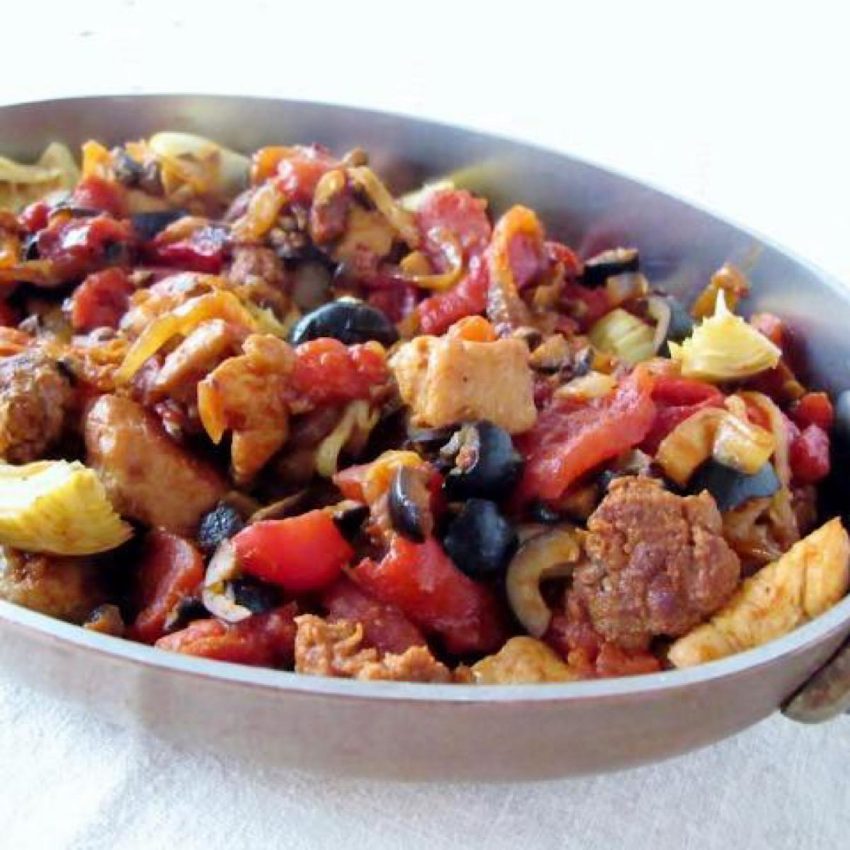
Where is Basque Country?
The Basque country is often said to straddle the border between Spain and France. The Basque people inhabited the region before those nations existed, but once Spain and France entered the picture, they brought their regional cuisines with them.
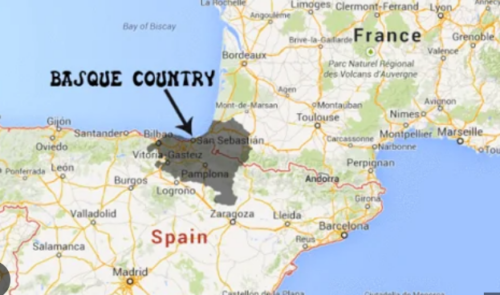
My daughter was fortunate enough to do a study abroad program in Spain, and her parents were fortunate enough to visit her and eat the wonderful dishes of the Basque region.
This Basque chicken and chorizo dish was inspired by that study abroad trip to Spain, and it turned out delicious, even though made in Minnesota!
What is Basque Cooking?
The Basque cuisine includes both a coastal influence of fish and seafood as well as a robust inland cuisine dominated by fresh and cured meats, as well as many vegetables and legumes.
Both the French and Spanish influence is strong, but the classic dishes are notably different on each side of the border.
Basques have incorporated ingredients from new settlers over time, like chocolate, potatoes, and various peppers. The Espelette pepper from France for example is strongly associated with Basque cooking and olive oil is the predominant oil used in cooking.
This recipe for Piperade is another classic Basque dish of tomatoes, onions, and peppers that is paired with many different meats or fish.
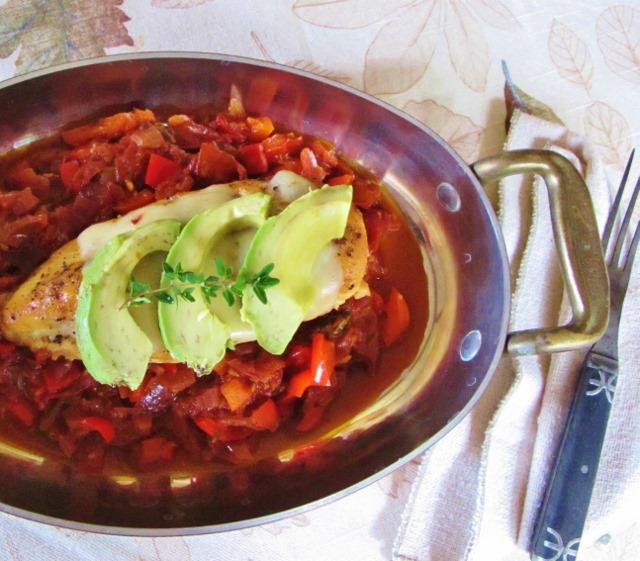
Basque cuisine is a local cuisine that draws from a rich, fertile inland area and a distinctive coastal area.
Pork, lamb, game meats and lake fish are abundant in the inland countryside and a wide range of seafood makes up the cuisine from the coastal area.
All in all, It is a very old cuisine with many traditional recipes passed down from generation to generation.
Spanish Chorizo vs Mexican Chorizo?
The chorizo that is typically used in the recipe below is Spanish—small, dense, smoked sausages made from coarsely chopped fatty pork and seasoned with mild Spanish paprika, salt, and garlic. When you see the deep red chorizo in the store, that is going to be the smoky Spanish version.
Alternatively, the Mexican version of chorizo is fresh, raw pork which is typically seasoned with vinegar and a variety of chile peppers. Mexican chorizo can be quite complex with the brighter spiciness of chile peppers that are not smoked.
Mexican chorizo and Spanish chorizo are indeed different flavor profiles, so they aren’t truly interchangeable.
They are both excellent however and if your dish calls for Spanish and all there is in the store is Mexican, use it! You will still end up with a robust flavor-filled dish.
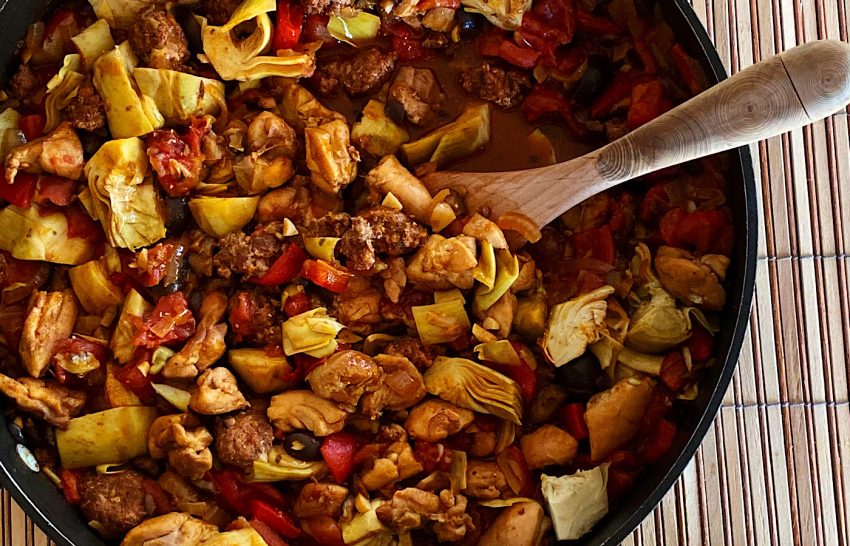
Ingredients and Substitutions
Substitutions for Basque Peppers
Bell peppers native to Mexico and Central America became a classic pepper used in Spanish cuisine. The French added a different kind of pepper to Basque cooking, a pepper called Piment d’Espelette, or Espelette pepper.
The Espelette pepper is sweet like the bell pepper, but also has a slightly smoky taste with a bit of heat.
I have grown the Espelette pepper on our farm, but it is not easy to find in an American grocery store. A substitute for this pepper would be to use sweet paprika with a little bit of a hotter pepper like cayenne.

Illustrated Step by Step:
Here are the steps lined out with photos. For the details of the recipe itself, see the recipe card below.
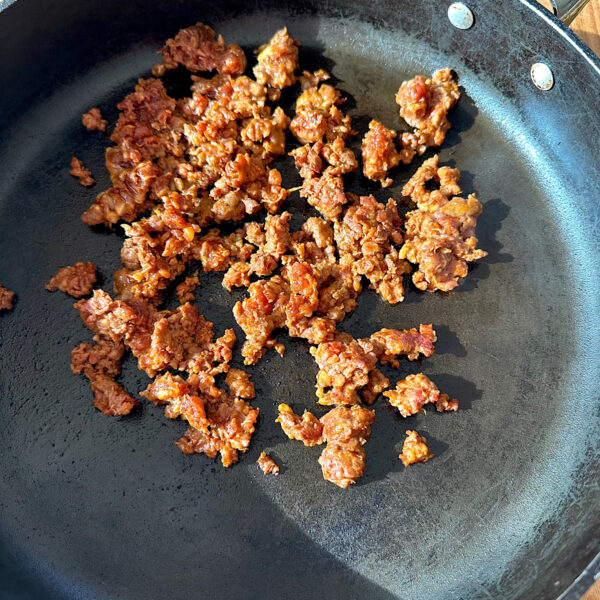
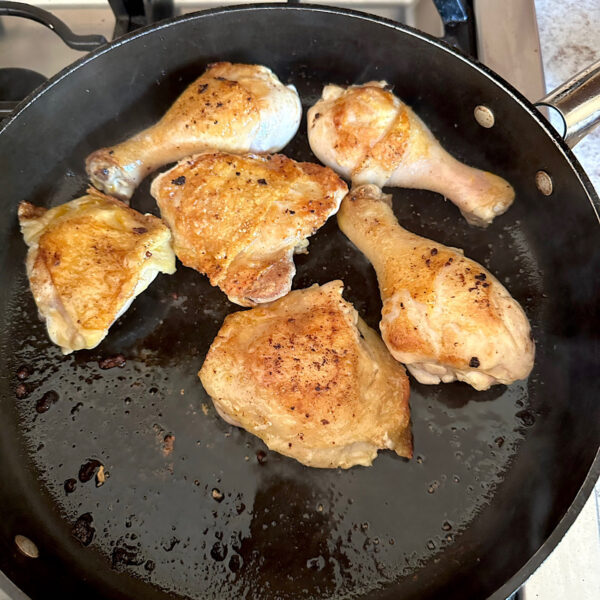
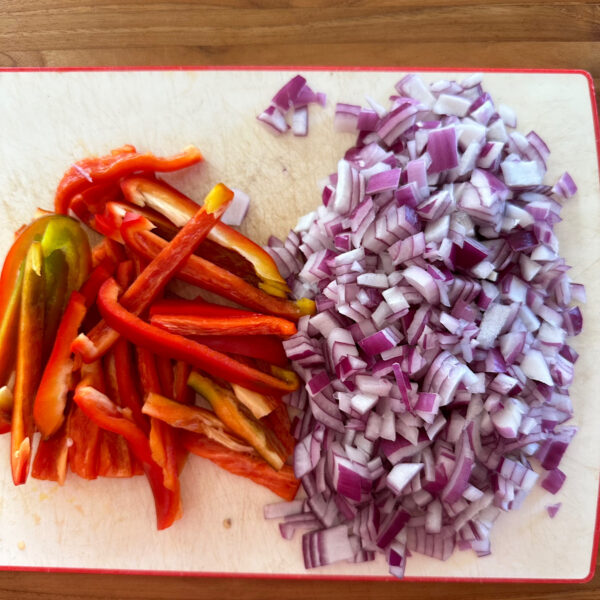
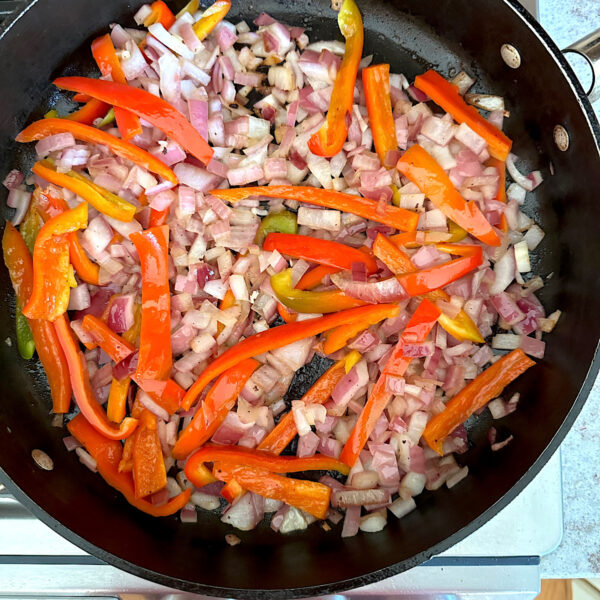


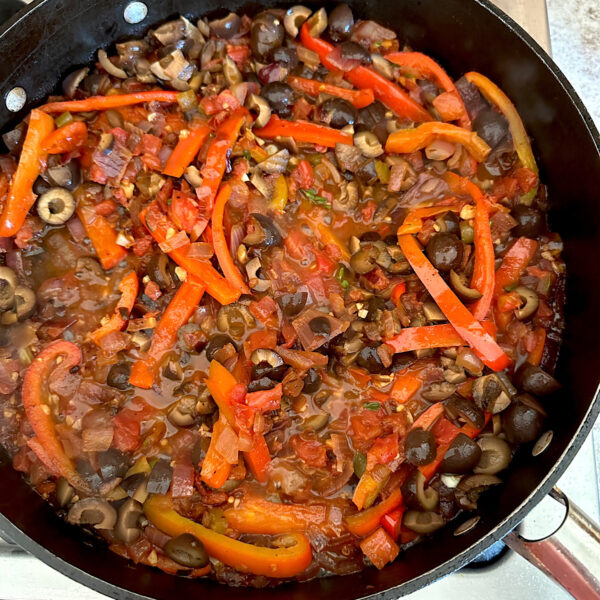

If you like my articles about cooking and gardening, subscribe to my weekly newsletter, where I share free recipes and gardening tutorials.
Basque Chicken and Chorizo Skillet Dinner
Equipment
Ingredients
- 6 ounces chorizo sausage Ground (you could also slice it into coins if it comes in a sleeve)
- 2-3 tablespoons Olive oil
- 3 pounds chicken I used 3 legs and 3 thighs; you could also use breast meat cut into bite-sized pieces (about 1 inch)
- ½ teaspoon salt
- ¼ teaspoon black pepper
- 2 large red sweet peppers can be from a jar
- 1 large onion sliced thinly or chopped
- 6 cloves garlic minced
- 14-16 ounces tomatoes diced (can use canned or fresh)
- 14 ounces black olives drained and coarsely chopped
- ¾ cup dry sherry
- 2 teaspoons paprika
- ¾ teaspoon crushed red pepper
- 9 ounces artichoke hearts Frozen or jarred
Instructions
- Over medium-high heat, heat up a large skillet with deep sides. Add the chorizo to the skillet and lightly brown for 3-5 minutes, rendering the fat. Transfer chorizo to a plate, leaving the fat in the skillet.6 ounces chorizo sausage
- Season the chicken with salt and pepper. Keeping the skillet at medium-high, add the oil and the chicken to the skillet and cook until browned on all sides (about 5-10 minutes). Remove the chicken to the plate with the chorizo.2-3 tablespoons Olive oil, 3 pounds chicken
- Add the red sweet peppers and chopped onion and cook until softened (about 5 minutes). Add the garlic, tomatoes, olives, dry sherry, paprika and crushed red pepper and cook for 1 minute, scraping up any browned bits from the pan.Salt and pepper to taste1/2 teaspoon salt, 2 large red sweet peppers, 1 large onion, 6 cloves garlic, 14-16 ounces tomatoes, 14 ounces black olives, 3/4 cup dry sherry, 2 teaspoons paprika, 3/4 teaspoon crushed red pepper, 1/4 teaspoon black pepper
- Return the chicken and chorizo to the skillet, cover, and turn the heat down to low. Simmer, covered, for 20-25 minutes.
- Add the quartered artichoke hearts, raise the heat to medium and cook uncovered until the sauce is slightly thickened (5-10 minutes).9 ounces artichoke hearts
- If not on the SCD, serve with crusty French bread.
Video
Notes
Nutrition
Online Diet/Health Coaching:
Although I am not currently taking clients for diet & health coaching, I was a coach for many years with the online service called coach.me. It is a great platform for all kinds of coaching – anything from specific diets, writing a blog, getting up early, or getting rid of that pesky procrastination.
There are some wonderful coaches and the testimonials will tell you what you need to know. Contact me at [email protected] to get a referral to some of the tested, experienced online coaches on Coach.me.

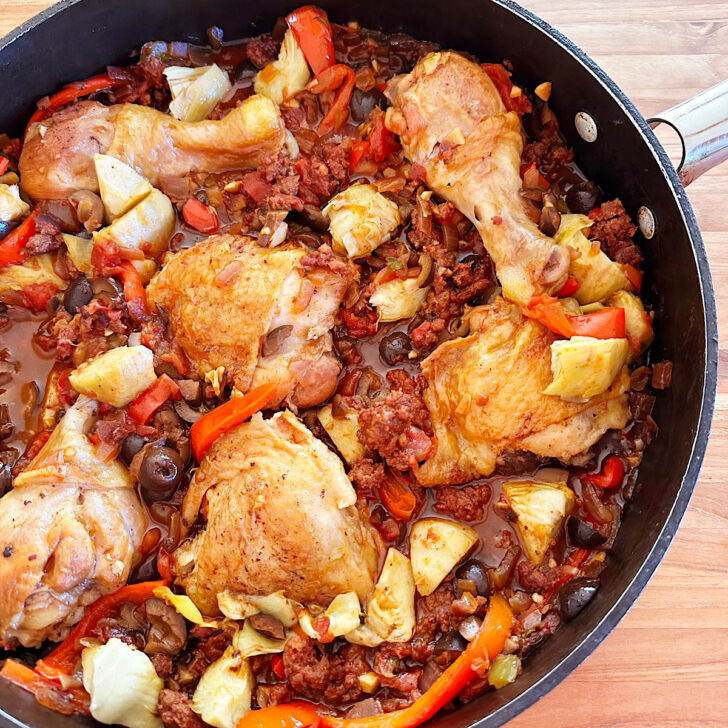
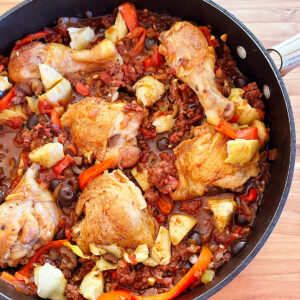
[…] Basque Chicken and Chorizo – Slow Carb – Farm to Jar Food […]
This dish was very good. However was way too spicy hot. My husband who loves basque food couldn’t even eat that much of it. I cut the red pepper flakes by half also. Is there something I can next time to lower the heat of this dish without sacrificing the flavor?
Hi Shelly, and thank you for the comment. This dish has a lot of robust flavor to it and it does not suffer at all by removing all of the red pepper flakes. Most of the heat/spiciness is coming from the red pepper flakes, with a small amount from the smoked paprika. Leaving in the smoked paprika, or maybe adding a little bit more smoked paprika and removing the red pepper flakes should give you a dish that doesn’t sacrifice flavor but removes the heat. Just know that smoked paprika varies quite a bit from source to source. Most of it is mildly spicy, but you may run across some that is quite spicy. Give it a little taste before using. The red pepper flakes don’t vary that much in heat….they are fairly standaridized.
I am making this dish today and am wondering what type of onion works best? I have yellow cooking onions, red onion and white sweet onion.
Also, is there another alcohol substitute for dry sherry? I don’t have any but I do have other liquors.
Thank you.
Penny
@dorothy stainbrook,
I made this dish and it turned out great! I used dry white vermouth in place of the dry sherry. They yellow onions were perfect.
Thank you for a delicious supper!!
Penny
Makes my day when people make something they like and it turns out according to plan!! So glad you liked it….and thank you for commenting.
@dorothy stainbrook,
Thank you so much for your quick reply!
I will use yellow onions and dry white vermouth 🙂
Penny
Hi Penny, Re the onions: the yellow onion is the all-purpose onion and has a balance astringency and sweet in their flavor, becoming sweeter the longer they cook.
White onions tend to have a sharper and more pungent flavor than yellow onions. They can be cooked just like yellow onions, but they tend to be more tender and so work well raw in things like salsas and chutneys.
Purple onions are similar to yellow onions in flavor, but their layers are slightly less tender and meaty. Purple onions are most often used for their color and relatively mild flavor.
Bottom line: any of the onions would work, but I’d go with the all-purpose yellow onions.
Re the dry sherry: you can sub in white vermouth or a dry white wine and it will be just fine.
Excellent !
Thank you for leaving a comment! It is quite helpful to know what is working and what is not.
I made this for my husband and in-laws and we all loved it!
Thanks for commenting! My hubby likes this one also.
Hi! Will cured basque chorizo work for this? Thanks!
Yes, but it will taste a bit different and have a different texture. The cured chorizo will be more smoky and the texture will not be as tender. Still good though!